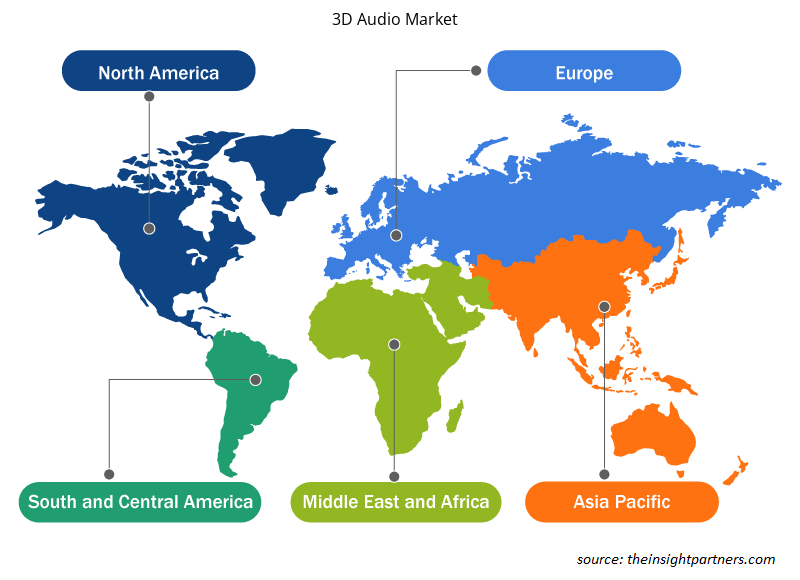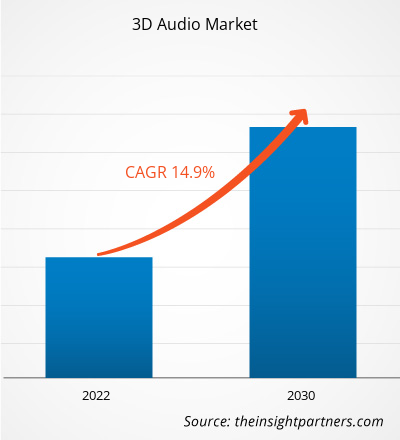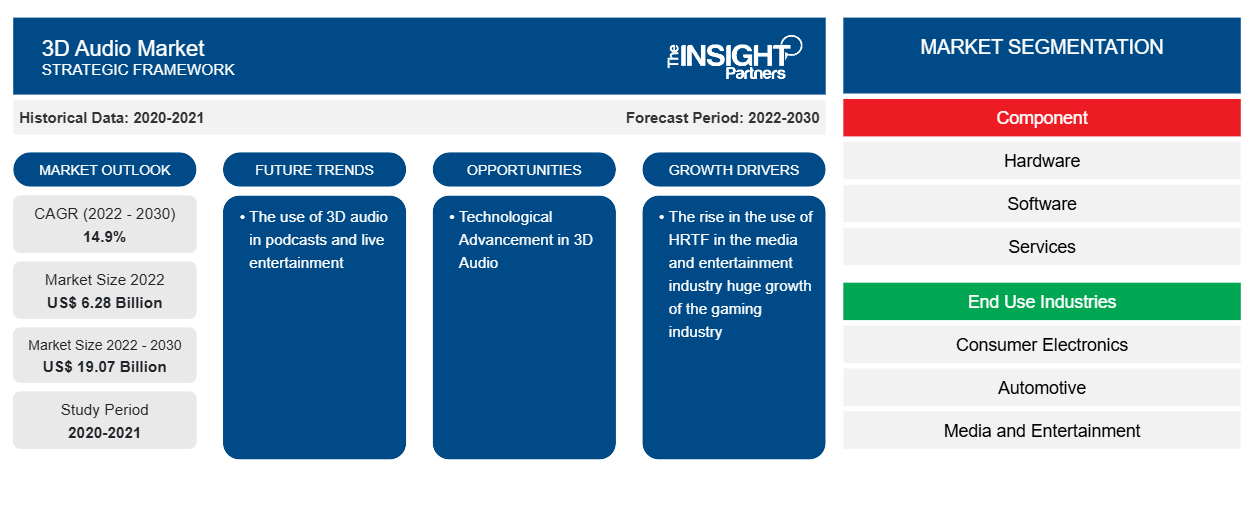[Forschungsbericht] Der 3D-Audiomarkt wurde im Jahr 2022 auf 6,28 Milliarden US-Dollar geschätzt und soll bis 2030 19,07 Milliarden US-Dollar erreichen; von 2022 bis 2030 wird eine durchschnittliche jährliche Wachstumsrate (CAGR) von 14,9 % erwartet.
Perspektive eines 3D-Audio-Marktanalysten:
Die kontinuierlichen Entwicklungen im Medien- und Unterhaltungssektor und die Einführung moderner AV-Technologien treiben das Wachstum des 3D-Audiomarktes voran . Die 3D-Audiohersteller konzentrieren sich auf die Integration von Sound-Mix-Technologie in die Hardware, um den Zuhörern in einem 3D-Raum verbesserte Musik (Sound) zu bieten. Auch die Verbreitung der Gaming-Industrie beflügelt den 3D-Audiomarkt. Darüber hinaus bietet die wachsende Neigung zum Online-Streaming von 3D-Musik den Akteuren des 3D-Audiomarktes eine lukrative Gelegenheit. Darüber hinaus sind viele im 3D-Audiomarkt tätige Unternehmen an der Produktentwicklung beteiligt. So kündigte beispielsweise Agora, Inc., ein Pionier und eine führende Plattform für Echtzeit-Engagement-APIs, im Februar 2023 die Einführung von Agora 3D Spatial Audio an; es handelt sich um eine Lösung, die es Entwicklern ermöglicht, dynamisches, immersives Audio in digitale Echtzeiterlebnisse einzufügen. Ebenso ging Audioscenic im Januar 2022 eine Partnerschaft mit Razer und THX ein, um eine Desktop-Soundbar mit 3D-Beamforming-Technologie und Head-Tracking-KI auf den Markt zu bringen. Somit treibt die zunehmende Innovation der Marktteilnehmer das Wachstum des 3D-Audiomarktes voran.
Marktübersicht für 3D-Audio:
Ein 3D-Audio-Soundsystem ist ein Akustiksystem, das den Benutzern Klang in einem dreidimensionalen Raum bietet. Der 3D-Audioeffekt ist ein Muster verschiedener Soundeffekte, die von 3D-Lautsprecherarrays, Stereolautsprechern, Kopfhörern und Surround-Sound-Lautsprechern erzeugt werden. Diese Systeme werden in einer Vielzahl von Anwendungen installiert, beispielsweise in Mobilgeräten, Spielekonsolen, AR/VR -basierten Audiosystemen, Heimkinosystemen usw. Darüber hinaus implementieren Branchen wie die Automobilindustrie, Unterhaltungselektronik sowie Medien und Unterhaltung 3D-Audiosysteme, um ihren Benutzern ein verbessertes 3D-Klangerlebnis und Echtzeitvisualisierung zu bieten.
Passen Sie diesen Bericht Ihren Anforderungen an
Sie erhalten kostenlos individuelle Anpassungen an jedem Bericht, einschließlich Teilen dieses Berichts oder einer Analyse auf Länderebene, eines Excel-Datenpakets sowie tolle Angebote und Rabatte für Start-ups und Universitäten.
-
Holen Sie sich die wichtigsten Markttrends aus diesem Bericht.Dieses KOSTENLOSE Beispiel umfasst eine Datenanalyse von Markttrends bis hin zu Schätzungen und Prognosen.
Markttreiber:
Steigende Nutzung von HRTF im Medien- und Unterhaltungssektor treibt Wachstum auf dem 3D-Audiomarkt an
Die Verwendung von fortschrittlichen Technologien wie Head-Related Transfer Functions (HRTF) nimmt in der Medien- und Unterhaltungsbranche zu. Akteure auf dem globalen 3D-Audiomarkt arbeiten daran, die HRTF-Technologie zu integrieren, um das Benutzererlebnis zu verbessern. Beim Ansehen von Filmen auf Smartphones mit Kopfhörern ist 3D-Audio immersiver als 2D-Audio. In der Filmindustrie simuliert die HRTF-Integration 3D-Audio, wenn gespiegelte Klänge die Ohren aus mehreren Richtungen durch verschiedene Lautsprecher erreichen, die sich an allen vier Seiten eines Raums befinden. Die HRTF wird für eine breite Palette von Soundgeräten, einschließlich Kopfhörern, implementiert, um einen ausgeprägten Surround-Sound-Eindruck zu erzeugen. Verbraucher sind zunehmend daran interessiert, Heimkinosysteme zu installieren , die das Erlebnis der HRTF nutzen. Verbraucher, die HRTF verwenden, erhalten eine Zertifizierung namens Dolby Digital, die auf Surround-Sound-Effekten basiert. Die HRTF-Verarbeitung wird auch mithilfe von Software emuliert, ohne dass externe Hardware verwendet wird, um Surround-Sound zu erzeugen.HRTF) is growing in the media & entertainment industry. Players in the global 3D audio market are working on merging the HRTF technology for improved user experience. When watching movies on smartphones with earphones, 3D audio is more immersive than 2D audio. In the film industry, HRTF integration simulates 3D audio when mirrored sounds reach the ears from multiple directions through various speakers located on all four sides of a space. The HRTF is implemented for a wide range of sound devices, including headphones, to provide a distinct surround sound impression. Consumers are increasingly interested in installing HRTF. A certification called Dolby Digital is given to consumers using HRTF, which is based on surround sound effects. HRTF processing is also emulated using software without the use of any external hardware to produce surround sound.
Darüber hinaus investieren Kopfhörerhersteller in Produkte, die HRTF-Technologie integrieren, um den Benutzern die bestmögliche 3D-Hörumgebung zu bieten. Im Januar 2023 erweiterte JBL seine neuen Headsets der JBL Quantum-Serie. Nach dem Erfolg seines ersten kabellosen Gaming-Headsets – dem JBL Quantum TWS – brachte das Unternehmen auch den nächsten Teil der Serie auf den Markt – das JBL Quantum TWS Air. Daher treibt der stetige Anstieg der Verwendung von HRTF im Medien- und Unterhaltungssektor das Wachstum des 3D-Audiomarktes voran.
Segmentierung und Umfang:
Der 3D-Audiomarkt ist nach Komponenten, Endverbrauchsbranchen und Geografie segmentiert. Basierend auf Komponenten ist der Markt in Hardware, Software und Dienstleistungen segmentiert. Das Hardwaresegment ist weiter segmentiert in Lautsprecher, Kopfhörer, Mikrofone und andere. Basierend auf Endverbrauchsbranchen ist der Markt segmentiert in Verbraucher, Automobil, Medien & Unterhaltung, Gaming und Gewerbe. Darüber hinaus ist der Markt basierend auf Geografie segmentiert in Europa, Nordamerika, den Nahen Osten und Afrika (MEA), Asien-Pazifik (APAC) und Südamerika (SAM).
Segmentanalyse:
Basierend auf den Komponenten ist der 3D-Audiomarkt in Hardware, Software und Dienste unterteilt. Lautsprecher, Kopfhörer, Bluetooth-Lautsprecher, Mikrofone , Soundbars und andere Hardware-Soundsysteme sind im Hardwaresektor enthalten. Binaurale Soundsysteme werden in 3D-Audiohardware verwendet, um Audiowellen zu erfassen, zu verarbeiten und wiederzugeben. Der Zweck des 3D-Audiohardwaresystems besteht darin, dem Zuhörer ein Hörerlebnis zu bieten, das das echte Leben nachahmt. Darüber hinaus werden 3D-Audioaufnahmen mit zwei Mikrofonen gemacht. Die Mikrofone erfassen gleichzeitig Ton in zwei Kanälen. Software modifiziert die Aufnahme, um die winzigen Signalschwankungen zu imitieren, die auftreten, wenn jedes Ohr Nachrichten an das Gehirn überträgt. Dieses Konzept wird als Biomimetik bezeichnet. Im Gegensatz zu Surround-Sound, bei dem mehrere externe Lautsprecher verwendet werden müssen, um gerichtete Audioquellen bereitzustellen, kann 3D-Audio nur über Kopfhörer erlebt werden.
Regionale Analyse des 3D-Audiomarktes:
Der globale 3D-Audiomarkt ist in Nordamerika, Europa, MEA, APAC und SAM unterteilt. Im Jahr 2022 hatte der asiatisch-pazifische Raum den größten Anteil am 3D-Audiomarkt, gefolgt von Europa und Amerika. Darüber hinaus wird erwartet, dass APAC im Prognosezeitraum die höchste CAGR verzeichnet. Das Wachstum des 3D-Audiomarkts in APAC ist auf die Präsenz verschiedener Hersteller von Unterhaltungselektronik , Automobilherstellern und der Unterhaltungsindustrie in der Region zurückzuführen, die eine enorme Nachfrage nach Verstärkern erzeugen. Darüber hinaus sind die zunehmende Nutzung von Unterhaltungselektronik wie Fernsehgeräten und Smartphones, das steigende verfügbare Einkommen, die zunehmende Verbreitung intelligenter und fortschrittlicher Geräte und die Präsenz lokaler 3D-Audioanbieter einige Faktoren, die das Wachstum des Marktes in der Region ankurbeln. China hält aufgrund seiner hohen Produktionskapazitäten und niedrigen Arbeitskosten den größten Anteil am 3D-Audiomarkt in APAC.
Analyse der wichtigsten Akteure auf dem 3D-Audio-Markt:
Barco NV; Dolby Laboratories Inc; Auro Technologies; Sound Particles SA; XPERI HOLDING CORPORATION; Waves Audio Ltd; Sennheiser electronic GmbH & Co. KG; Fraunhofer; VisiSonics; und THX Ltd sind die wichtigsten Akteure auf dem 3D-Audio-Markt, die in dem Bericht porträtiert werden.
Regionale Einblicke in den 3D-Audiomarkt
Die regionalen Trends und Faktoren, die den 3D-Audiomarkt im Prognosezeitraum beeinflussen, wurden von den Analysten von Insight Partners ausführlich erläutert. In diesem Abschnitt werden auch die 3D-Audiomarktsegmente und die Geografie in Nordamerika, Europa, im asiatisch-pazifischen Raum, im Nahen Osten und Afrika sowie in Süd- und Mittelamerika erörtert.

- Holen Sie sich die regionalen Daten für den 3D-Audiomarkt
Umfang des 3D-Audio-Marktberichts
| Berichtsattribut | Details |
|---|---|
| Marktgröße im Jahr 2022 | 6,28 Milliarden US-Dollar |
| Marktgröße bis 2030 | 19,07 Milliarden US-Dollar |
| Globale CAGR (2022 - 2030) | 14,9 % |
| Historische Daten | 2020-2021 |
| Prognosezeitraum | 2022–2030 |
| Abgedeckte Segmente |
Nach Komponente
|
| Abgedeckte Regionen und Länder |
Nordamerika
|
| Marktführer und wichtige Unternehmensprofile |
|
Dichte der Marktteilnehmer für 3D-Audio: Die Auswirkungen auf die Geschäftsdynamik verstehen
Der Markt für 3D-Audio wächst rasant. Die Nachfrage der Endnutzer steigt aufgrund von Faktoren wie sich entwickelnden Verbraucherpräferenzen, technologischen Fortschritten und einem größeren Bewusstsein für die Vorteile des Produkts. Mit der steigenden Nachfrage erweitern Unternehmen ihr Angebot, entwickeln Innovationen, um die Bedürfnisse der Verbraucher zu erfüllen, und nutzen neue Trends, was das Marktwachstum weiter ankurbelt.
Die Marktteilnehmerdichte bezieht sich auf die Verteilung der Firmen oder Unternehmen, die in einem bestimmten Markt oder einer bestimmten Branche tätig sind. Sie gibt an, wie viele Wettbewerber (Marktteilnehmer) in einem bestimmten Marktraum im Verhältnis zu seiner Größe oder seinem gesamten Marktwert präsent sind.
Die wichtigsten Unternehmen auf dem 3D-Audio-Markt sind:
- Barco NV
- Dolby Laboratories Inc
- Auro Technologies
- Sound Particles SA
- XPERI HOLDING CORPORATION
- Waves Audio GmbH
Haftungsausschluss : Die oben aufgeführten Unternehmen sind nicht in einer bestimmten Reihenfolge aufgeführt.

- Überblick über die wichtigsten Akteure auf dem 3D-Audiomarkt
Jüngste Entwicklungen auf dem 3D-Audiomarkt:
Die Akteure auf dem 3D-Audiomarkt verfolgen in hohem Maße anorganische und organische Strategien. Nachfolgend sind einige aktuelle wichtige Marktentwicklungen aufgeführt:
- Im Jahr 2023 erwarb CEVA das Spatial Audio Business von VisiSonics, um sein Anwendungssoftwareportfolio für eingebettete Systeme für Wearables und andere Consumer-IoT-Märkte zu erweitern.
- Im Jahr 2023 gab Xperi Inc. eine Partnerschaft mit LG Electronics bekannt, um die immersive Audiotechnologie DTS:X in die neuesten OLED- und Premium-LCD-Fernseher von LG zu integrieren. DTS, Inc. – eine hundertprozentige Tochtergesellschaft von Xperi Inc. – hat sich zum Ziel gesetzt, die Welt durch seine bahnbrechenden Audiolösungen für Mobilgeräte, Heimkino und andere Anwendungen besser klingen zu lassen.
- Im Jahr 2023 präsentierte NEWAURO BV, einer der führenden Anbieter von immersiver Soundtechnologie für Home-Entertainment-Systeme der nächsten Generation, auf der Consumer Electronics Show in Las Vegas seine neue Soundbar-Systemplattform. Die vollständig integrierte Lösung umfasst die neueste Auro-Scene-Lautsprechervirtualisierungstechnologie. Sie ermöglicht Geräteherstellern den Bau fortschrittlicher Soundbar-Systeme von Stereo bis 7.1.4, einschließlich der Unterstützung konfigurierbarer Satellitenlautsprecher.
- Im Jahr 2023 stellte Dolby Laboratories, einer der führenden Anbieter von immersiven Unterhaltungserlebnissen, seine neueste Innovation im Bereich immersiver Audioqualität vor: Dolby Atmos FlexConnect. TCL, eine weltweit führende TV-Marke, wird als erster Anbieter Dolby Atmos FlexConnect in seinem TV-Sortiment 2024 implementieren.
- Im Jahr 2022 gaben THX Ltd. und VisiSonics, ein führender Anbieter von 3D-Raumklangtechnologien, die die Leistung der Endbenutzer verbessern und akustische Umgebungen optimieren, bekannt, dass THX bestimmte 3D-Audio- und Personalisierungstechnologien von VisiSonics lizenziert hat und diese in seine Produkte integriert. VisiSonics-Technologien werden in THX Spatial Audio-Tools für Spieleentwickler und Musikproduzenten eingesetzt und treiben die THX-Audiopersonalisierung für Headset-Hersteller voran.
- Im Jahr 2021 kündigte Dolby Laboratories an, dass Dolby Atmos Teil des neuen Surreal Sound-Systems mit 21 Lautsprechern von Lucid Air sein wird und ein wirklich beeindruckendes Hörerlebnis sowie verbesserte aktive Audio-Sicherheitsfunktionen im Auto bietet.
- Im Jahr 2021 kündigte Auro Technologies an, dass Yamaha sein 3D-Audioformat AURO-3D auf seinen neuesten AVENTAGE AV-Receiver-Systemen anbieten wird.
- Im Jahr 2021 hat AURO Technologies die AURO-3D Creative Tools Suite 3.0 veröffentlicht. Die neueste Version der Creative Tools Suite bietet eine ganze Reihe neuer Funktionen. Der Zugriff auf alle Hauptfunktionen der Creative Tools Suite wird einfacher und ermöglicht reibungsloses Arbeiten in AURO-3D.
- Im Jahr 2021 gab Fraunhofer IIS, der Hauptentwickler des MPEG-H 3D-Audiostandards, bekannt, dass die Sony Corporation (Sony) die MPEG-H 3D Audio Baseline Profile Decoder-Software von Fraunhofer lizenziert und dem MPEG-H Trademark Program beigetreten ist.
- Historische Analyse (2 Jahre), Basisjahr, Prognose (7 Jahre) mit CAGR
- PEST- und SWOT-Analyse
- Marktgröße Wert/Volumen – Global, Regional, Land
- Branchen- und Wettbewerbslandschaft
- Excel-Datensatz
Aktuelle Berichte
Verwandte Berichte
Erfahrungsberichte
Grund zum Kauf
- Fundierte Entscheidungsfindung
- Marktdynamik verstehen
- Wettbewerbsanalyse
- Kundeneinblicke
- Marktprognosen
- Risikominimierung
- Strategische Planung
- Investitionsbegründung
- Identifizierung neuer Märkte
- Verbesserung von Marketingstrategien
- Steigerung der Betriebseffizienz
- Anpassung an regulatorische Trends























 Kostenlose Probe anfordern für - 3D-Audio-Markt
Kostenlose Probe anfordern für - 3D-Audio-Markt